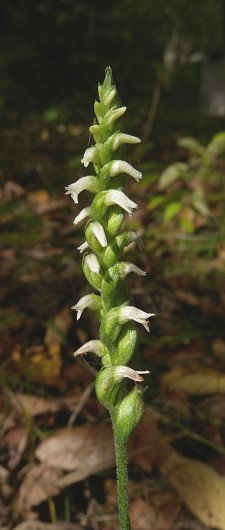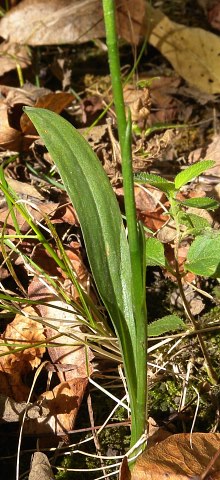 Description:
This perennial wildflower is 3-12" tall, consisting of an unbranched
flowering stalk, 1-2 basal leaves, and a few alternate leaves. Usually,
individual plants are less than 7" tall. The basal leaves are 1-6" long
and ¼-¾" across; they are lanceolate, oblanceolate, or elliptic in
shape, while their margins are smooth. The alternate leaves are located
along the lower half of the flowering stalk; they are often bladeless
and sheath-like, but sometimes there are blades ¾-2½" long and about ¼"
across. When alternate blades are present, they are narrowly
lanceolate, oblanceolate, or elliptic, and their margins are smooth.
Both basal and alternate leaves are medium to dark green and glabrous.
The erect central stalk is medium to dark green, terete, and relatively
narrow; it is glabrous below, becoming short-pubescent and glandular
above. This stalk terminates in a spike of flowers about ¾-4" long. The
flowers of each spike are densely arranged into 3-ranks (a double
spiral). Each flower has 6 white tepals, a green ovary, and other
reproductive organs. The tepals form a tubular corolla about 4-5 mm.
long that is slightly curved and nodding. The corolla has an upper hood
consisting of 3 fused tepals, a lower lip consisting of a single tepal,
and 2 lateral tepals. As each flower develops, the lateral tepals
become free toward the base and extend along the sides of the corolla.
The lower lip extends to about the same length, or slightly beyond the
hood. This lip is somewhat
recurved, narrowly oval in shape, and its margins are slightly undulate
and crisped. At the base of the lip, there is a pair of slender curved
callosities (resembling minute claw-like extensions). The interior of
the corolla is usually white, otherwise it is pale cream. The ovary is
medium green, ovoid-oblongoid in shape, usually short-pubescent, and
about 4-5 mm. long (although it becomes larger after the blooming
period). Partially obscuring the ovary, there is a green bract (about
5-8 mm. in length) that is lanceolate-elliptic, short-pubescent, and
glandular. The blooming period occurs during the early fall, sometimes
extending into mid-fall. The flowers bloom
from the bottom to
the top of the raceme. Afterwards, the seed capsules develop, becoming
about the same length as the bracts; they are sessile and
ovoid-oblongoid in shape. Eventually, these capsules release numerous
minute seeds that are carried aloft by air currents. The root system
consists of a few roots that are fleshy and fibrous.
Description:
This perennial wildflower is 3-12" tall, consisting of an unbranched
flowering stalk, 1-2 basal leaves, and a few alternate leaves. Usually,
individual plants are less than 7" tall. The basal leaves are 1-6" long
and ¼-¾" across; they are lanceolate, oblanceolate, or elliptic in
shape, while their margins are smooth. The alternate leaves are located
along the lower half of the flowering stalk; they are often bladeless
and sheath-like, but sometimes there are blades ¾-2½" long and about ¼"
across. When alternate blades are present, they are narrowly
lanceolate, oblanceolate, or elliptic, and their margins are smooth.
Both basal and alternate leaves are medium to dark green and glabrous.
The erect central stalk is medium to dark green, terete, and relatively
narrow; it is glabrous below, becoming short-pubescent and glandular
above. This stalk terminates in a spike of flowers about ¾-4" long. The
flowers of each spike are densely arranged into 3-ranks (a double
spiral). Each flower has 6 white tepals, a green ovary, and other
reproductive organs. The tepals form a tubular corolla about 4-5 mm.
long that is slightly curved and nodding. The corolla has an upper hood
consisting of 3 fused tepals, a lower lip consisting of a single tepal,
and 2 lateral tepals. As each flower develops, the lateral tepals
become free toward the base and extend along the sides of the corolla.
The lower lip extends to about the same length, or slightly beyond the
hood. This lip is somewhat
recurved, narrowly oval in shape, and its margins are slightly undulate
and crisped. At the base of the lip, there is a pair of slender curved
callosities (resembling minute claw-like extensions). The interior of
the corolla is usually white, otherwise it is pale cream. The ovary is
medium green, ovoid-oblongoid in shape, usually short-pubescent, and
about 4-5 mm. long (although it becomes larger after the blooming
period). Partially obscuring the ovary, there is a green bract (about
5-8 mm. in length) that is lanceolate-elliptic, short-pubescent, and
glandular. The blooming period occurs during the early fall, sometimes
extending into mid-fall. The flowers bloom
from the bottom to
the top of the raceme. Afterwards, the seed capsules develop, becoming
about the same length as the bracts; they are sessile and
ovoid-oblongoid in shape. Eventually, these capsules release numerous
minute seeds that are carried aloft by air currents. The root system
consists of a few roots that are fleshy and fibrous.Cultivation: The preference is dappled sunlight to light shade, moist to mesic conditions that are well-drained, and soil containing loam or clay-loam with some decaying organic matter. In addition to these requirements, appropriate strains of a fungus or fungi should be present in the soil that can form a symbiotic association with the root system.
 Range
& Habitat: The native Lesser Ladies' Tresses has
been found mostly in southern and central Illinois, where it
is uncommon (see
Distribution
Map).
However, this species appears to be slowly spreading
into other parts of the state. Habitats include moist to mesic
woodlands, rocky upland woodlands, open woodlands, areas along
paths in woodlands, edges of swamps, and semi-shaded areas along
abandoned fields. Lesser Ladies' Tresses appears to flourish when
disturbance reduces competition from shrubs, trees, and tall
vegetation. Such disturbance may be related to fire, wind storms, or
human actions. In the wooded habitats where this wildflower occurs, the
dominant trees are deciduous.
Range
& Habitat: The native Lesser Ladies' Tresses has
been found mostly in southern and central Illinois, where it
is uncommon (see
Distribution
Map).
However, this species appears to be slowly spreading
into other parts of the state. Habitats include moist to mesic
woodlands, rocky upland woodlands, open woodlands, areas along
paths in woodlands, edges of swamps, and semi-shaded areas along
abandoned fields. Lesser Ladies' Tresses appears to flourish when
disturbance reduces competition from shrubs, trees, and tall
vegetation. Such disturbance may be related to fire, wind storms, or
human actions. In the wooded habitats where this wildflower occurs, the
dominant trees are deciduous.Faunal Associations: Various kinds of bees visit the flowers of Spiranthes spp. (Ladies' Tresses Orchids) for nectar, including bumblebees, Halictid bees, leaf-cutter bees (Megachile spp.), and little carpenter bees (Ceratina spp.). The foliage and flowers are browsed occasionally by mammalian herbivores, including the White-Tailed Deer, Cottontail Rabbit, and Groundhog. Because of its small size and inconspicuous nature, Lesser Ladies' Tresses can be overlooked by these herbivores, however.
Photographic Location: In a wooded area of a park in Champaign County, Illinois.
Comments: There are two varieties of Lesser Ladies' Tresses. The typical variety requires cross-pollination by insects to produce fertile seeds; it is found in several southern states. The other variety, Spiranthes ovalis erostella, has a more northern distribution that includes Illinois. This latter variety lacks some of the reproductive structures (specifically, the rostellum and viscidium) that prevent self-pollination. Therefore, in the absence of cross-pollination by insects, this variety of Lesser Ladies' Tresses is capable of self-pollination, increasing the likelihood that seeds will be produced. Lesser Ladies' Tresses can be distinguished from other Spiranthes spp. (Lady Tresses' Orchids) by its small size (typically 3-6" tall), small flowers (tepals less than 6 mm. long), and narrow flowering stalks. In particular, the base of the lower lip of each flower has a pair of slender curved callosities (resembling minute claw-like extensions) that are distinct for this species. In contrast, the callosities of a more common species, Spiranthes cernua (Nodding Ladies' Tresses), resemble a pair of wart-like protuberances at the base of the lower lip of each flower. This distinction usually requires a 10x hand lens to see.